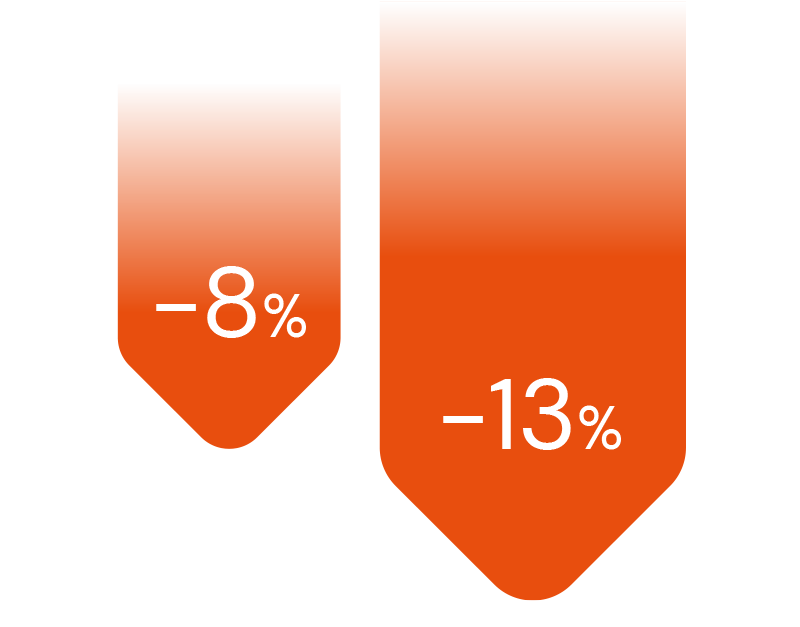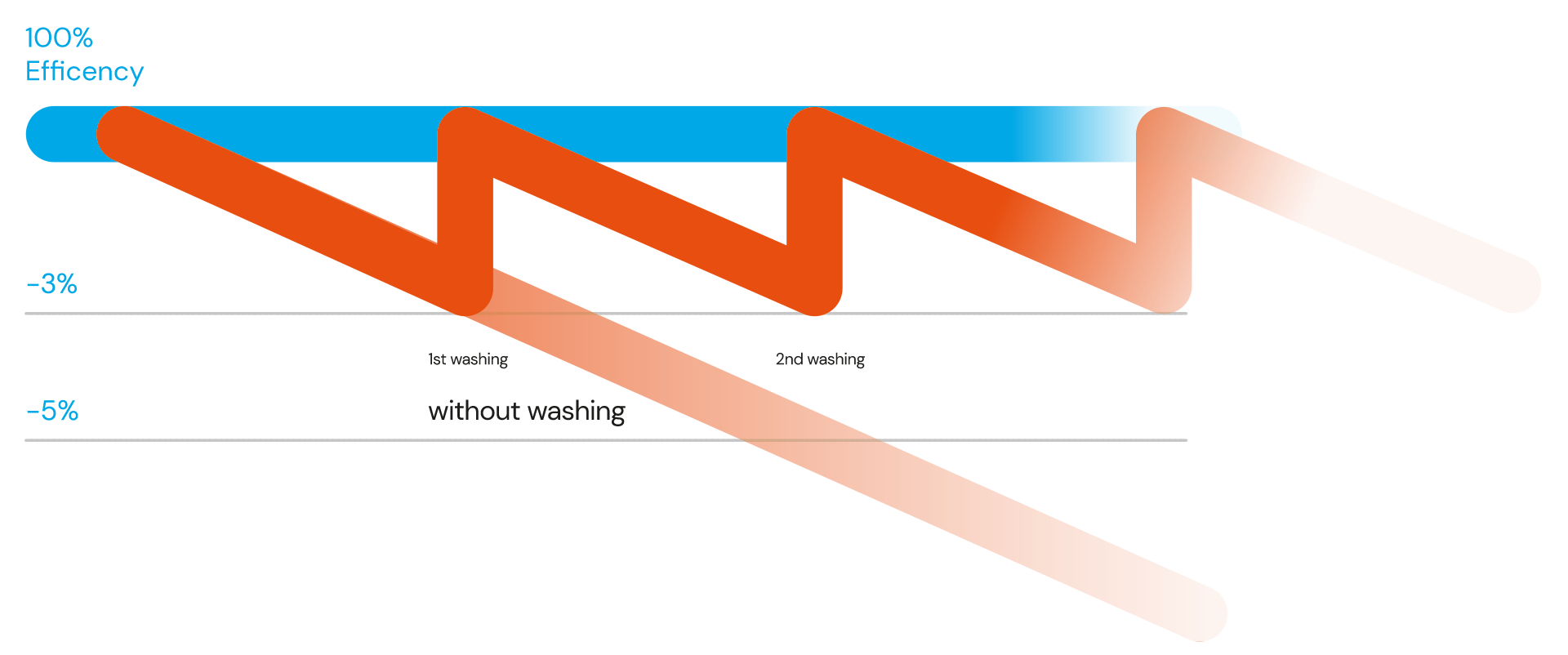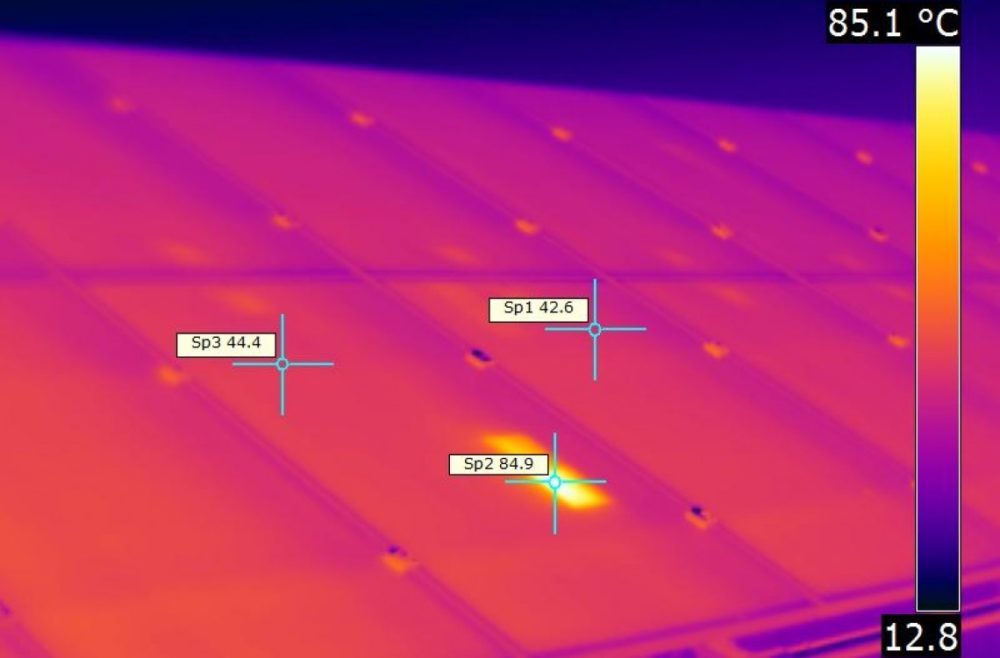Why clean solar panels?
It is clear enough that when your panels are dirty you renounce to a percentage of their production capacity. This means that you are losing money. A loss on the investment represents a real issue as a PV plant as well as a solar park require a great expense, up to thousands of euros, even up to a hundred thousand. What is the point in allocating such an investment if then you do not take the most of it?

Clouds are not the problem.
A proper cleaning of your plant
can positively affect your revenue.
Dust, smog, leaves regularly drop off the panels and deposit sediment.
Rainwater alone cannot remove all the dirt effectively. Sometimes the rain itself is responsible for bringing impurities which cover the entire panels surface creating an opaque layer. Consequently, the plants effectiveness reduces by 8-13% in a short time, and even by 20% in some critical cases.
It is essential to consider that even small spots, such as leaves or excrements, could cause a severe damage in terms of energy production, with a remarkable loss on the effectiveness level.
As well as a plumbing system, a damaged PV panel could affect the whole circuit. Another risk is a localized rise in temperature (hotspot effect) provoking irreversible damages.
Efficiency throughout the time

An efficiency loss directly corresponds to a loss of money.
It is fundamental to make a specialized and deep cleaning of your PV plant multiple times in a year. It should be considered that the cost of the cleaning service would be significantly lower than the economic profit that one gets from a totally efficient plant.
An overview of the economic damage provoked by a reduced efficiency (for example a 10% loss) can be found in the table below.
| 50 Kw | 100 Kw | 500 Kw | 1 Mw | |
|---|---|---|---|---|
| 1 year | € 2.450 | € 4.900 | € 24.500 | € 49.000 |
| 5 years | € 11.838 | € 23.280 | € 122.500 | € 232.800 |
| 10 years | € 22.050 | € 44.100 | € 245.000 | € 441.000 |
The illustrative calculation is based on the following parameters:
– Incentive average GSE 0,346€/KWh
– Average solar irradiation per year: 1400 hours (Bologna)
– Solar efficiency reduction due to dirt: 10%
It is crystal clear how important it is to preserve the efficiency of our plants through a periodical cleaning.
How much you can save
with a proper cleaning
A dirt solar plant over a farm roof or a manufacturing industry could produce an 8 to 20% loss in the first year taken alone.
As for PV parks, calculations combined with our experience show an efficiency decrease by 3% after the first year, reaching up to 5% during the second one, and up to 7% during the third one, before it gets to a stable point.
These percentages look lower than the roof loss as a PV parks is normally far from urbanized areas. But if we consider the huge production capacity of the plan it still comes with enormous losses, significantly reducing the goodness of the investment.
In order to understand the main filth causes we take into consideration
Dust and pollution of the environment
It is evident that a plant located in the nature gets less dirty than one located in a borough of a populated and polluted town.
Type of site
A roof plant located over a pork, bovine or poultry livestock would get dirtier rather than a plant located over a greenhouse.
Presence of smokes or detriments from opacifying agents
A plant installed next to smokestacks or chimneys can be relevantly more affected by smokes or dust produced by the industry, some of them are also opacifying.
Site proximity to polluted or dusted roads
Plants located next to fast-flowing arterial roads are extremely affected by the pollution, as well as those located close to quarries or rural roads.
For example, the loss of a 100-kw plant could suffer a revenue loss
from 5,000€ to 12,000€ depending on the incentive and on the inclination of the site to getting dirty.
This formula indicates the loss amount:
Pimp * Kins * Igse * Rspo
_______________________
100
• Pimp power plant in KWp (ex. 200KW)
• Kins coefficient of solar radiation (we can consider a national average of 1400)
• Igse GSE incentive value (we can consider 0,35€/KWh)
• Rspo percentual efficiency loss due to dirt (we can consider 10%)
If we consider the given values, the production loss of a 200KW-plant taken alone provokes a lack of earning amounting to 9.800 €, in addition to all extra problems related to a bad functioning of the modules.
Cleaning cost
Now we can explore an overview of the cleaning costs.
There are different types of solar panels and solar plants. It often happens that while they are being installed people do not think about the future maintenance and cleaning needs. Therefore, additional tools are required to complete a proper cleaning. Tail lifts are frequently required to enter between the modules.
The position of land modules within solar parks can vary as well as their height and the distance between the rows. All these factors can affect the cleaning activity cost.
Despite an inspection would always be the best way to collect all necessary information about the plant, we will provide you with a table illustrating some reference numbers referring to the washing cost of a roof pitch.
Reference costs for
PV plants cleaning
| Plant Power | Cleaning Cost |
|---|---|
| 100 ÷ 200 Kw | 5,00 €/Kw |
| 500 ÷ 1000 Kw (over a roof) | 2,60 €/Kw |
| 1 ÷ 10 Mw (land PV plant) | 1,50 €/Kw |
| 10 ÷ 20 Mw (land PV plant) | 1,35 €/Kw |
| > 20 Mw (land PV plant) | 1,25 €/Kw |
The given costs are provided as an example and are not binding. They can vary depending on the PV modules geometric development as well as on the presence of water on the site which could be used for cleaning. In case of a lack of water, a supply would be required.
A proper cleaning of the panels would immediately affect the investment. 1€ for cleaning corresponds to 10€ generated in terms of energy.
Our experience suggests that for a good plant maintenance a one-year cleaning could be enough, while in some cases it could be suggested to do extra cleaning activities mainly during the highest solar radiation time.










